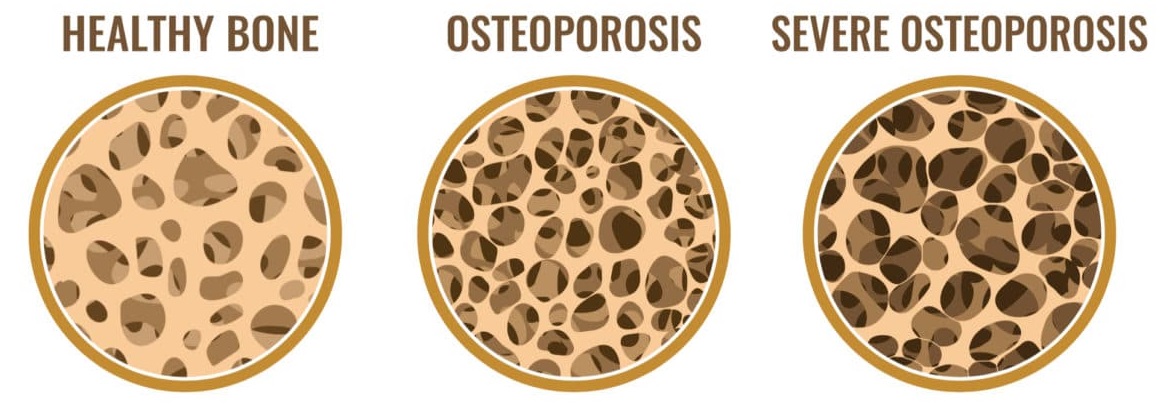Osteoporosis is a medical condition characterized by a loss of bone density, leading to brittle and weak bones that are more likely to fracture or break. The word “osteoporosis” literally means “porous bones.” It is a common condition, particularly in older adults, and affects women more often than men.
Osteoporosis is often referred to as a “silent disease” because there are typically no symptoms until a fracture occurs. Prevention and management of osteoporosis typically involves lifestyle modifications (such as exercise and a healthy diet rich in calcium and vitamin D), medications, and fall prevention strategies.
Symptoms of Osteoporosis
Osteoporosis often develops gradually over a long period of time, and many people with the condition may not have any symptoms until they experience a fracture (aka a broken bone).
In fact, the condition is often called a “silent disease” because many people may not realize they have it until they experience a fracture.
Causes of Osteoporosis
The causes of osteoporosis are more complex than you might think. There are a variety of contributing factors which may include:
- Aging: As we age, our bones naturally lose density and strength.
- Hormonal changes: Women are at a higher risk of developing osteoporosis due to the decrease in estrogen that occurs during menopause. Men can also experience hormonal changes that increase their risk of osteoporosis.
- Nutrition: Calcium and vitamin D are essential for strong bones, and a lack of these nutrients in your diet can increase your risk of osteoporosis.
- Physical activity: Regular physical activity helps maintain bone density and strength. A lack of exercise can increase your risk of osteoporosis.
- Smoking (tobacco) and alcohol: Both smoking and excessive alcohol consumption can increase your risk of osteoporosis.
- Medications: Certain medications, such as long-term use of corticosteroids and some anticonvulsants, can increase your risk of osteoporosis.
- Family history: A family history of osteoporosis can increase your risk of developing the condition.
While some lifestyle choices can increase your chance of developing osteoporosis, others, such as keeping a healthy weight and consuming enough calcium in your diet, can help prevent the illness from developing.
In addition to these measures, genetic factors may also play a role in determining whether or not someone develops osteoporosis later in life.
Osteoporosis Incidence / Frequency
Around 10 million Americans over 50 have osteoporosis, and an additional 34 million are at risk for the condition, according to a report by the US Surgeon General. Osteoporosis is around four times more common in women than men. In the USA, there are an estimated 1.5 million fragility fractures caused by osteoporotic fractures every year.
Risk Factors for Osteoporosis
- Age —Older than age 50
- Family history
- Smoking
- Gender —Female
- Race —Asian-Americans, African-Americans, and Hispanic/Latino Americans
Diagnosing Osteoporosis
If there is suspicion of osteoporosis, your doctor may order special imaging tests to diagnose and monitor the condition.
Bone Density Test
A bone density test measures how dense your bones are by using X-rays to measure how much calcium is bound to them.
The results of this test help determine if you have osteoporosis or low bone mass (known as osteopenia). It is done by X-ray each hand and wrist, then comparing these images to those taken years ago.
Dual Energy X-Ray Absorptiometry (DXA)
This scan uses two types of radiation—low energy and high energy—to measure bone density in the hip or spine.
You’ll lie on a table while the machine passes over your body with an X-ray beam that measures low-density areas (osteoporosis) and higher-density areas (normal bones).
The result is compared against normal values for age, sex, and race or ethnicity; if there is less than 95 percent mineralization in any part of these two bones, you are at risk for osteoporosis.
Osteoporosis T-Score
A t-score is calculated based on the imaging, and helps grade the severity of osteoporosis. A t-score measures how strong your bones are based on how much mineral content they have compared with normal bone tissue of people of the same age and sex group.
Treatment for Osteoporosis
Osteoporosis can be prevented or treated by taking medicine, regularly exercising (especially weight-bearing exercises like walking), and not smoking.
Medications
Medications may be prescribed if you have osteoporosis. Some come in the form of pills and others as injections or IV infusions.
Bisphosphonates
Bisphosphonates are usually the first choice treatment for osteoporosis. Bisphosphonates work by slowing down cells in the bone called “osteoclasts”, which break down old bone. Examples of bisphosphonates are Alendronate (Fosamax) which is a weekly pill, and Zoledronic acid (Reclast), a yearly IV infusion.
Hormone replacement therapy (HRT)
In women, estrogen is the main hormone that helps to protect bones, so it’s often used in hormone replacement therapy (HRT). It can also help with hot flashes and vaginal dryness.
Lifestyle Changes
There are several lifestyle changes that can help treat and manage osteoporosis, including:
- Regular exercise: Engaging in regular weight-bearing exercises, such as walking, jogging, or resistance training, can help maintain bone density and strength. Consult with your doctor to determine a safe exercise plan.
- Adequate calcium and vitamin D intake: Consuming enough calcium and vitamin D is essential for maintaining strong bones. Good sources of calcium include dairy products, leafy green vegetables, and fortified foods. Vitamin D can be obtained through sun exposure, certain foods, or supplements.
- Fall prevention measures: Falls can increase the risk of fractures, so taking steps to prevent falls is crucial. This includes ensuring that your home is free of tripping hazards, using assistive devices such as handrails and grab bars, and wearing appropriate footwear.
- Avoiding smoking and excessive alcohol consumption: Both smoking and excessive alcohol consumption can increase the risk of osteoporosis and contribute to bone loss.
Making these lifestyle changes can help slow bone loss, increase bone density, and reduce the risk of fractures. Consult with your doctor to determine the best approach for managing your osteoporosis based on your individual needs and circumstances.
